by Paul Braterman
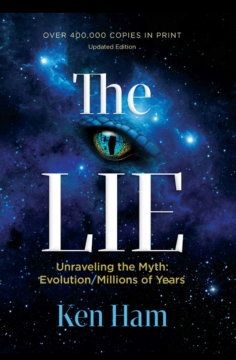
You need to take Ken Ham seriously. This entrepreneurial Brisbane high school teacher has put together the world’s largest Young Earth creationist organization, Answers in Genesis (AiG). This has a worldwide presence, publishes its own magazine, Answers, and emails a constant stream of highly repetitive messages to its followers. It has built the Creation Museum in Kentucky, as well as the Ark Encounter, featuring a (very unbiblical) so-called replica of Noah’s Ark, and now plans a replica of the Tower of Babel. Its annual income (June 2022 filing) was over $60 million, its YouTube channel has 667,000 subscribers, and its website claims over a million visits each month.
So what? Bible Belt lunatic fringe? Unfortunately no. AiG has allies who are close to the center portion of power, and who will be even closer to the center of power should Donald Trump once again become President.
Ken Ham has among his friends Mike Johnson, Speaker of the US House of Representatives, whose law firm represented AiG pro bono in a successful attempt to ensure Kentucky State funding for its activities, despite its fundamentally religious nature, which goes so far as to require all employees accept its six-day creationist Statement of Faith. And among the contributors to its magazine is Calvin Beisner, director of the Cornwall Alliance, whose entire purpose is to deny the importance of human-caused climate change. Cornwall in turn has direct links to the Heartland Institute and to the Heritage Foundation, authors of Project 2025.
If you have not studied modern creationism, you may well think that it is a curious aberration, like flat-earthism, regrettable in its denial of whole areas of science, but otherwise (!) harmless. Not so.
The modern creationist movement in the US is not only about the beginning of the world, but about its ending. Genesis is pivotal, but so is Revelation. So are the many hints of the end of the world that are explicit in the New Testament, and can be discovered with sufficient ingenuity in the Old.
Such thinking underlines the apocalyptic tone that underlies current US right-wing politics. If the Earth does not have a deep past, we cannot expect it to have a prolonged future. We should not be concerning ourselves with conservation, but with righteousness.
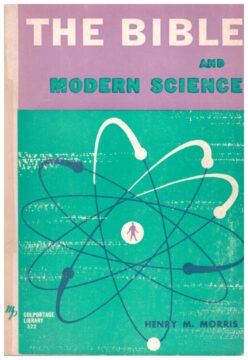 The individual responsible more than any other for the resurgence of Young Earth creationism in the second half of the 20th century is Henry Morris, co-author with John Whitcomb of The Genesis Flood, the movement’s foundational document. But a decade before this, Morris had written a much shorter book, The Bible and Modern Science, whose final chapter is devoted to claims that biblical prophecies are being fulfilled in our own times, and are signs of Christ’s imminent return. Prominent among these is the return of Jews to their ancestral homeland. Similar thinking explains why US fundamentalist evangelicals are now among Israel’s most unquestioning supporters.
The individual responsible more than any other for the resurgence of Young Earth creationism in the second half of the 20th century is Henry Morris, co-author with John Whitcomb of The Genesis Flood, the movement’s foundational document. But a decade before this, Morris had written a much shorter book, The Bible and Modern Science, whose final chapter is devoted to claims that biblical prophecies are being fulfilled in our own times, and are signs of Christ’s imminent return. Prominent among these is the return of Jews to their ancestral homeland. Similar thinking explains why US fundamentalist evangelicals are now among Israel’s most unquestioning supporters.
You will find a succinct summary of Young Earth thinking, and clues to how Young Earth creationism has developed politically, in The Lie, the book whose 1987 and 2024 editions I am reviewing here. (I suspect that few readers here will need persuading that the Young Earth position is misguided, and that the evidence for evolution is overwhelming, but for reference let me mention the Index of Creationist Claims, and 29+ Evidences for Evolution.)
My method was to write a review of the older version (1st ed), and then go through the later (3rd ed), modifying what I had written to show the development of the movement of which AiG is a part. (Unless otherwise stated, everything in 1st ed is also in 3rd ed, though I have ignored minor changes in wording and layout.) I was shocked by what I found. The connection between creationism and right-wing American politics goes back over a century, as discussed in Carl Weinberg’s Red Dynamite, and is present in 1st ed, but has become much more prominent in 3rd ed, which raises issues completely unrelated to its ostensive theme while promoting the agenda of present-day American Christian Nationalism.
Otherwise, there is not much difference between the two editions, though 3rd ed is more repetitious and, where direct comparison is possible, less vigorous use of language, and more hectoring, than the original.
According to Ham himself, it was The Lie that positioned Answers in Genesis as a biblical authority ministry. That is a strange reading of history, since when it was published in 1987, Ham was an employee of Morris’ Institute for Creation Research. Ken Ham had come to the US in 1984, after establishing himself as an effective creationist spokesman in Australia. He then worked for seven years with Morris’ Institute for Creation Research, achieving great success as a writer and speaker, before breaking away to form his own organization, which developed into Answers in Genesis, while his Australian partnerships gave rise to what is now a completely separate organization, Creation Ministries International (here I pass over much unseemly and litigious infighting). Ken Ham has a great talent for self-promotion, and very recently, Answers in Genesis has announced the opening of an Australia-based branch, thus continuing its long-standing policy of out-competing its own colleagues
Ham’s approach is unsubtle, uncompromising, and unburdened with excess erudition. It is also completely devoid of originality, since all the ideas he expresses are already there in the writings of Henry Morris and his precursors. The book describes itself as concerned with “the foundational nature of the book of Genesis to all Christian doctrine.” By “the book of Genesis,” Ham means a plain literal meaning, with a 6-day 24-hour creation, ignoring two millennia of exegesis and two centuries of literary and archaeological scholarship, and reducing the beautiful, complex, many-layered text to a cardboard cutout.
The title of the first chapter tells us that “Christianity is Under Attack,” or, in 3rd ed, “Under Massive Attack”. Modern society has moved away from Christ, but the book promises to outline “a Biblical (and therefore successful)” approach. Note the assumption that calling something “Biblical” guarantees that it is in every way correct.
 3rd ed takes the opportunity to claim victimhood for Christianity, and to attack an unspecified secular wokeness, signaling the book’s political tendency. It then shows a figure cataloguing our modern ills; Abortion, Pornography, Paedophilia, Transhumanism, racism, LGBTQ, CRT (Critical Race Theory, which accuses our social institutions of structural racism), Inclusion, Identity Politics, Social Justice, Transgenderism, Mandates, Intersectionality (which advocates common cause between the victims of different kinds of social injustice), No Religious Freedom, and Woke, all combined together in the Secular Worldview.
3rd ed takes the opportunity to claim victimhood for Christianity, and to attack an unspecified secular wokeness, signaling the book’s political tendency. It then shows a figure cataloguing our modern ills; Abortion, Pornography, Paedophilia, Transhumanism, racism, LGBTQ, CRT (Critical Race Theory, which accuses our social institutions of structural racism), Inclusion, Identity Politics, Social Justice, Transgenderism, Mandates, Intersectionality (which advocates common cause between the victims of different kinds of social injustice), No Religious Freedom, and Woke, all combined together in the Secular Worldview.
This is an extraordinary list. Something very strange is happening when those who call themselves followers of Christ object to the idea of social justice. Of the 16 items on this list, seven (CRT, Inclusion, Identity Politics, Social Justice, Mandates, Intersectionality, and Woke) express political views, with some of which one might have expected a follower of Jesus to sympathise, and none bear any relationship to the book’s ostensive agenda.
It gets worse. 3rd ed at this point questions the concept of separation of church and state, asserts that the public education system is not neutral, since it teaches naturalistic explanations, quotes Matthew 12:30 that one is either for Christ or against him, and says that
To help parents understand the reality of the situation, I suggest we say “anti-God schools” instead of public (secular) schools to remind us of what these institutions really are.
Since the public school system teaches naturalistic explanation, it is indoctrinating into a religion of atheism, thus undermining Christianity and Christian morality. Here we have the reason for creationist advocacy of voucher schemes, designed to use public funds for children to be educated at creationist schools, and for homeschooling.
We soon meet an asymmetry of argument that is foundational to Ham’s approach. He denies that he needs to tolerate different religious beliefs, since
[T]his ‘tolerance’ really means an intolerance of the absolutes of Christianity
[Emphasis in original, here and throughout] and
It is not a matter of whether you are dogmatic or not, but which dogma is the best dogma with which to be dogmatized!
For Ham, tolerance means acceptance of his right to impose intolerance and when people argue for tolerance, they are themselves showing intolerance towards the absolute truth of Biblical Christianity. There are only two possible world views – man’s word and God’s word – and there is no such thing as neutrality between them.
We soon meet Ham’s obsession with sexual behavior, especially homosexuality. Here the book is disarmingly open. We know that homosexuality is wrong because marriage is defined in Genesis as union between one man and one woman for life, and because homosexuality is condemned in numerous Bible verses. But without the Bible, we would not have convincing reason for calling it wrong, although it clearly is. Thus, in a typical creationist circular argument, homosexuality is wrong because the Bible says so, and the Bible’s condemnation of homosexuality confirms that biblical morality is correct.
Ham pre-empts the scientific case for evolution by arguing that since it concerns past history, it is not science at all. For science involves repeatable observations, and we cannot repeat the past.
This argument is central to the creationist claim that the evolutionist and creationist perspectives are philosophically at the same level, since they both depend on using faith to go beyond the evidence. It is what Ham used, when teaching, to undermine students’ confidence in the scientific curriculum. It is also very attractive argument, since those who accept it believe that they have been granted a superior insight, and he commends its use in schools.
Logically at least, it is easily refuted. In geology and paleontology, we have multiple examples on which we can repeat our observations. Devonian marine sandstones always date within the same age range, and always contain Devonian fish, never ichthyosaurs (much later), or whales (later still). And even when we are interested in a singular event, we do not need to repeat the past in order to repeat our observations about it. Scientific evidence – DNA tests of relatives – has shown that the biological father of Justin Welby, Archbishop of Canterbury, was not the man named on his birth certificate, and we can repeat the tests, if we wish, without having to beget more archbishops. And it is DNA testing, more than any other single method, that present-day evolution science uses in order to establish family relationships, common ancestry, and the relative times of divergence between different groups of living things.
There follows an argument that to most readers will seem a bizarre self-serving sophistry, but to which I think Ham is completely committed. Unbelievers, and scientists (for him the two terms seem at times interchangeable) claim to be following the evidence, but the evidence is always interpreted in terms of their own prior beliefs (this is true). It follows that they cannot be persuaded by evidence, since that would involve their ceasing to be unbelievers. Thus, in emphatic font,
It is not a matter of whether one is biased or not. It is really a question of which bias as the best bias with which to be biased.
Here Ham is claiming that for all of us, presupposition and identity trump evidence. Indeed, it is virtuous to cling to presuppositions, as long as they are the right ones. That’s faith, and faith is of course necessary for salvation. I think that he is genuinely incapable of understanding the scientific commitment to fallibilism, the acknowledgement, at least in principle, that what we now believe is always open to revision in response to new arguments and evidence. For him, invulnerability to evidence is a virtue, an attitude that may explain why he and those like him are able to carry on supporting Trump.
It gets worse. There is only one way and people can come to believe in the Bible, and that is with the operation of the Holy Spirit. We are, all of us, either “for Christ or against Him.”
Evolutionists (I will accept his term for those who accept the standard scientific account of deep time and common descent) are unable to understand the creationist position, which is:
As creationists, we understand that God created a perfect world and fell into sin, the world was cursed, God sent Noah’s Flood as judgment, and Jesus Christ came to die and be raised from the dead to restore all things.…
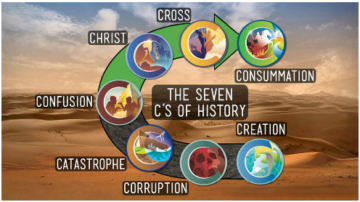 At this point, 3rd ed tells us that
At this point, 3rd ed tells us that
At the Creation Museum, we summarize biblical history as the Seven C’s of History — Creation, Corruption, Catastrophe, Confusion, Christ, Cross, and Consummation.
As Susan and William Trollinger point out in their book about the Museum, these 7 C’s are strongly reminiscent of the 7 D’s of dispensationalism, a premillennialist interpretation of history. Both editions continue with
However, because evolutionists are used to thinking in “uniformitarian” terms (i.e. basically the world we see today – the world of death and struggle – has gone on for millions of years), they do not understand this creationist perspective of history.
Ham is incapable of even considering the possibility that unbelievers, and believers whose theology is different from his own, understand his position perfectly well but reject it. As for the mountains (literally) of evidence for the uniformity of nature over time, he will claim that he is free to reject all of it, since, as we have seen, inferences about the past are assumption-ridden and unscientific. Since his own thinking is, as he says, presupposition, he sees views opposed to his as imposed on the evidence, rather than emerging from it. We do not merely presume that rain in the distant past was the same as rain today; we see raindrops on desert sandstone that predates the dinosaurs.
 R: Raindrops on Coconino desert sandstone, Grand Canyon, 275 million years old. Answers in Genesis tells us that this sandstone, along with the rest of the Grand Canyon sediment, was laid down by fierce torrents during Noah’s Flood.
R: Raindrops on Coconino desert sandstone, Grand Canyon, 275 million years old. Answers in Genesis tells us that this sandstone, along with the rest of the Grand Canyon sediment, was laid down by fierce torrents during Noah’s Flood.
Worse, he appears completely oblivious to the fact that his own interpretation of Genesis is heavily laden with assumptions. Or if he is, he no doubt attributes them to the operation within him of the Holy Spirit.
Christians who accept the findings of secular science are being inconsistent. If they choose to accept millions of years, they have succumbed to the disease of naturalism, of which evolutionism is merely a symptom. And naturalism is itself a religion, since by denying God’s role it is a form of atheism.
All this in the book’s first chapter. The remaining 150 pages add little new.
Chapter 2 tells us that “Evolution is Religion,” because it comes to conclusions without adequate evidence, and the evidence is inadequate because, as we saw earlier, it involves extrapolation to the unobservable past. Furthermore, it is a misguided religion because its conclusions conflict with “the irrefutable evidence of the Scriptures.” All secular knowledge is uncertain, because we cannot know everything, but God does know everything, and so we can have perfect confidence in what He tells us.
Chapter 3, “Creationism is Religion”, tells us that the Creation took place in six days, and God called it “very good.” It follows that there was no death, all animals were vegetarians, the climate was mild from pole to pole, and there was no bad weather. However, this Edenic state of affairs did not last. Why not?
Because our first parents placed human opinion above God’s word (as we continue to do), struggle and death entered the world and God cursed the creation.
The wickedness of later generations brought on Flood, and the billions of fossils laid down the Flood sediments (all sediments, we take it, are Flood sediments) remind us of “God’s judgment on sin.” Nonetheless, after the Flood the earth once again became filled with corruption because of human sin. Christ’s death and resurrection conquered death, and through Him we may be born into eternal life.
Thus as surely as God created the world and judged the world with the Flood, our ungodly world will be destroyed by fire. For those who trust in Jesus, however, there awaits eternal life in the new heavens and new earth.
3rd ed covers the same ground in greater detail, once again invoking the 7 C’s, and presenting Ham’s interpretations as if they were God-given.1
This is the core of Christianity, as represented by Answers in Genesis, and the movement of which it is part. It is a curious form of Christianity, reducing it almost to a commercial transaction. What you have to do, is trust in Jesus. And He in return will give you eternal life, after this world has been destroyed. Nothing here about love your enemies, turn the other cheek, blessed are the peacemakers, who is my neighbor, I was hungry and you fed me not.
A computer scan of 3rd ed shows 180 references to sin, and just 35 references to love, of which only 8 refer to love between human beings.
Biblical principles (at least the ones that Ken Ham has actually noticed) need to underpin all our beliefs. The evolutionist alternative is to say that we arose by random processes, in which case we would have no reason to trust our own brains (The fallacy, of course, is that natural selection is a very opposite of random, and if our brains didn’t do a pretty good job of keeping us alive, we wouldn’t be here.)
The evidence supports the Bible. Just like it says, living things from distinct kinds. World-wide sediments containing fossils confirm the biblical flood, while the close relatedness of all human groups is explained by their spreading out from a single group at Babel. Nearly all cultures have flood legends and creation legends, similar to Genesis. The Babylonian flood legend is a distorted folk memory of the true, biblical account.
Chapter 4, “The Root of the Problem,” accuses evolution of providing justification for rebellion against God. Evolution defenders are equated with secular humanists, who cannot allow the possibility of God being Creator. They falsely claim that they aim to remove religion from the public schools, when in fact they have subverted the public schools into teaching the religion of humanism. (But aren’t there entire denominations that accept evolution science? Ham deals with them later.) There is no proof of evolution. As we are told, with emphasis, in both editions,
All the evolutionists have to do is to come up with one piece of evidence that conclusively proves evolution.
This absence of conclusive evidence is central to the creationist argument that evolution is religion, not science and that the vehemence with which its defenders claim otherwise demonstrates their moral corruption. By contrast, Romans 1:20 clearly states that God’s nature is evident through His creation, and that those who deny him (this, for Ham, includes all those who do not share his Young Earth creationist beliefs) are without excuse.
It is difficult to know how to deal with an argument so confidently presented while being totally at variance with reality (right now, the problem also arises in areas other than evolution). The evidence for evolution was conclusive, by all reasonable standards, over a century ago. Moreover, the time interval between the 1987 and 2024 editions of the book have produced further layers of evidence, based on the DNA similarities that I referred to earlier. The creationist organizations themselves are well aware of these developments. However, as I mentioned earlier, Ham has set up his rules of evidence in advance, in such a way as to be free to ignore them. We see here the rhetorical device of demanding the impossible. Ham is asking for proof, but has already stated that the relevant evidence is unacceptable. He then uses the absence of proof that he would regard as acceptable, as conclusive evidence that his opponents are arguing in bad faith.
Chapter 5, Crumbling Foundations, argues that
Every single Biblical doctrine of theology, directly or indirectly, ultimately has its basis in the book of Genesis.
And
Genesis provides an account of the origin of all the basic entities of life and the universe: the origin of life, of man, of government, of marriage, of culture, of nations, of death, of the chosen people, of sin, of diet and clothes, of the solar system… the list is almost endless.
To which 3rd ed adds, significantly,
The meaning of all these things is dependent on their origin. For example, to properly discuss climate change, one has to start with the creation/Flood account in Genesis or one will not have a correct understanding of what happens in our present world.
For example, Genesis gives us the doctrine of marriage as the union between one man and one woman for life.
I am reduced to wondering whether Ham has actually read Genesis. For if he did, what he would find there is arranged marriage to preserve the bloodline, fathers selling their daughters, concubinage, polygamy, women procuring their slavegirls as breeding stock for their husbands, and levirate marriage, whose purpose is to provide a dead man with an heir.
For the rest, it is hardly surprising that since Genesis is an account of humankind’s earliest history, it also provides what are said to be the earliest examples of all kinds of human activity. As for the solar system, Ham really does claim to believe that the earth was created before the sun, and cheerfully discards the whole of planetology and cosmology.
For him, that is a small price to pay in order to preserve the foundations, which depend on accepting God and accepting the guidance that he finds in Genesis. For if we abandon this, we will have act according to our own opinions. That is completely unacceptable, a repetition of the sin of Adam in the garden, and the source of all the evil in the world.
This chapter gives a few other examples of what Ham claims to be biblical teaching. He says that the Bible tells us that from the point of conception (in the 2024 edition, of course, this becomes the point of fertilization), we are human beings, so that abortion in all instances is killing a human being. Yet the Bible chapters that he himself cites (Psalm 139, Jeremiah 1) speak of the child being formed in the womb; the very opposite of what he tells us. He objects to women pastors, because (no verse cited) God created men and women for separate roles. There are also vague references, again with no verse cited, to the process of appointing deacons, and strict discipline (I think he means spanking) for children. Ham’s version of biblical Christianity is shot through with such nonbiblical opinions, in all their lamentable fallibility.
Chapter 6, Genesis Does Matter, goes over what is by now familiar ground, with some notable additions. We are told that fathers have a God-commanded responsibility to be priest in their household, while (according to Paul in Ephesians) women should be submissive. Evolution is responsible for
pornography, abortion, homosexuality, lawlessness, euthanasia, infanticide, loose morals, and faithfulness in marriage and other such things
and
is an anti-God religion held by many people today justification for their continued pursuit of self-gratification and their rejection of God as Creator.
A great deal is said the need for clothes, in order to curb sexual arousal, and about humanity’s inherently sinful nature. Homosexuality is frequently mentioned, as in 3rd ed is transgenderism. (I and others more qualified think that we do indeed need a discussion about the upsurge in demand for so drastic an intervention, but for Ham there is nothing to discuss.) As further evidence of the growing politicization of AiG, 3rd ed goes out of its way at this point to mention Pres Obama’s and Pres Biden’s support for gay marriage.
Chapter 7 concerns Death – A Curse and a Blessing. A curse resulting from God’s necessary and righteous response to Adam’s sin, along with all the other evil in the world. But a blessing, because the death of Christ allows the conquest of death for all who believe in Christ as their Savior:
All who believe in Jesus Christ as Lord and Savior are received back to God to spend eternity with Him. Isn’t that a wonderful message? That is the message of Christianity.
There are of course, as I mentioned earlier, other aspects to Christianity, such as loving your neighbor, but the book seems strangely unaware of these.
Thus for Ham, salvation is contingent on Adam’s having sinned, further establishing the pivotal importance of a literal reading of Genesis. There are indeed evolution-accepting Christians, but through pride or ignorance they are undermining the basis of their own faith.
3rd ed now adds a long section presenting what it regards as conclusive evidence for a young earth, presumably directed at evolution-accepting Christians. It portrays the issue as one of authority. Once we question Biblical authority in one regard, we are free to question it in others, which is of course intolerable. Moreover, the fossil world shows the presence of death and disease, which only came into the world as a result of Adam’s sin, and therefore cannot predate humanity. Meat eating is even younger, dating to the time of Noah, but that also is found in the fossil record. And more arguments of the same kind.
The chapter moves on to discuss NEW HEAVENS AND NEW EARTH
This is paradise restored, where “there shall be no more curse” (Revelation 22:3), there will be no more death, and carnivores will revert to being vegetarian.
If you deny Young Earth creation, you are implying that there was death and suffering before human sin, and you are giving up the hope of the coming restoration. Furthermore, if you accept any kind of scholarly consensus that denies the plain meaning of the text, you are placing human opinion above God’s own word.
Chapter 8 tells us of The Evils of Evolution, which as we have seen include lawlessness, homosexuality, and abortion. Evolution is also to blame for Nazism, since Hitler believed in Darwinian struggle, and for racism. (The reality of course is that Biblical creationism was used to justify racism from the 18th to the late 20th Century, and from the slave-owning South to the writings of Henry Morris, Ham’s own sometime mentor).
The weakening of morality by evolution can lead to drugtaking, while Haeckel’s drawings, showing embryos as corresponding to less involved life stages, have been used to justify abortion.
3rd ed now goes out of its way to mention Planned Parenthood, which it describes as “one of the biggest child-killing ‘machines’ in the world,” and mentions in linked paragraphs that its founder, Margaret Sanger, was a fervent eugenicist, and that she promoted the use of birth control. As we have seen, the changes between 1st ed and 3rd ed tell us very plainly how AiG is developing politically, and we must take the reference to birth control very seriously.
Ham takes exception to the application of Darwinian thinking in business. The most efficient prevails, and this is somehow wrong. I have to ask, why?
Next, with no sense of irony, Ham tells us in successive paragraphs that evolutionary thinking has been used to defend male chauvinism, and that Christian women should not be deceived by the feminist movement, which is anti-God, since God has given men and women different roles. 3rd ed even warns us of the danger that “women will abuse their role and want to usurp the authority of the man in regard to headship.”
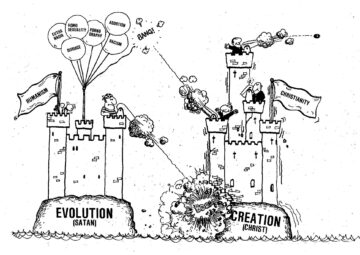 He then summarizes his arguments to date by a cartoon showing two opposing castles. The castle of Christianity is wasting its ammunition by firing at specific targets, while evolution, guided by Satan, attacks the Christian doctrine of creation. Such at least is what we see in the 1987 version, one of many scattered throughout the book, which do have a certain faux naïve charm. The 2024 version, by contrast, looks so bad that I wonder whether it is AI-generated. But notice the reference in this later version to Revelation.
He then summarizes his arguments to date by a cartoon showing two opposing castles. The castle of Christianity is wasting its ammunition by firing at specific targets, while evolution, guided by Satan, attacks the Christian doctrine of creation. Such at least is what we see in the 1987 version, one of many scattered throughout the book, which do have a certain faux naïve charm. The 2024 version, by contrast, looks so bad that I wonder whether it is AI-generated. But notice the reference in this later version to Revelation.
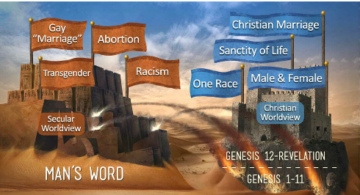 Chapter 9, Evangelism in a Pagan World, and Chapter 10, Wake Up, Shepherds! repeats the message that the only sound preaching is based on one particular interpretation of Genesis. Both editions go out of their way to attack and belittle Darwin, as is usual, but 3rd ed adds a remark so outrageous, that I cannot forbear from comment:
Chapter 9, Evangelism in a Pagan World, and Chapter 10, Wake Up, Shepherds! repeats the message that the only sound preaching is based on one particular interpretation of Genesis. Both editions go out of their way to attack and belittle Darwin, as is usual, but 3rd ed adds a remark so outrageous, that I cannot forbear from comment:
Since the time of Darwin, much research has shown that observational science (e.g., the study of genetics) does not confirm Darwin’s ideas but actually contradicts them.
Ham taught biology, and environmental biology was his degree major. He graduated in the early 1970s, and it is difficult to believe that he was unaware of the way in which the coming together of Mendelian genetics, classical paleontology, and the solving of the genetic code were placing evolution science on an ever-firmer foundation.
Chapter 10 begins by lamenting theologians and pastors who accept evolution, blames them for the rejection of Christianity among the young, and concludes with a self-revealing list of what Ham considers their errors. First among these is toleration. Ham accuses theological colleges of dogmatism, when they insist that their students consider diverse views of creation, and refrain from identifying only one (his) as correct. Next, accommodation, where “Christians just add evolution to the Bible.” (Disclosure: not only is it the case that the majority of Christians are in this sense accommodationists, but I have found such Christians to be among my staunchest allies in the defense of science.) Cooperation, where the church accepts the possibility of evolution, leads on to Contamination, where evolution becomes accepted within religious education, and ceases to bother people. This brings us to the final stage, Capitulation to Error, since rejection of Genesis leads, according to Ham, to rampant liberal theology.
Chapter 11, Creation, Flood, and Coming Fire, concludes the book’s central argument by linking the creation of this world to its imminent destruction. It starts with a quotation also used by Henry Morris in his 1951 book, The Bible and Modern Science. Ham devotes particular attention to this passage, and so should we:
There is a prophecy in II Peter concerning the last days of this earth’s history, and it very much relates to the whole creation/evolution issue:
II Peter 3:3-7 (NIV) states: “First of all, you must understand that in the last days scoffers welcome, scoffing and following their own evil desires. They will say, ‘Where is this coming He promised? Ever since our fathers died, everything goes on as it has since the beginning of creation.’ But they deliberately forget that long ago by God’s Word the heavens existed and the earth was formed out of water with water. By water also the world of that time was deluged and destroyed. By the same word the present heavens and earth are reserved for fire, being kept for the day of judgment and destruction of ungodly men.”
We see this prophecy being fulfilled in front of our own eyes. The people who tell us that “everything goes on as it has since the beginning of creation” are the evolutionists and deep time geologists. They use the principle that “the present is key to the past,” and invoke the observed present-day processes of sedimentation and mutation in their discussions of geology and evolution.
In this, they are “willingly ignorant”. They have deliberately chosen not to believe in the Genesis account of creation, God’s judgement of the world at the time of Noah’s Flood, and coming judgment by fire. If they do not think that the geological record is convincing evidence of the Flood, that is because they do not want to be convinced. And the reason why they do not want to be convinced is that they do not wish to acknowledge God’s authority, obey His rules, and stand in awe of the coming judgment by fire. The very fact that the Biblical account is being questioned is itself a fulfilment of Biblical prophecy, confirming (as if confirmation were required) that the Bible account is true.
The sun, moon, and stars are evidence of God’s creation. The sediments are evidence of God’s judgment in the Flood, and Last Day’s prophecies are being fulfilled before our eyes. And, just in case we haven’t got the point, a final quotation in bold from II Peter 3:11-12a:
Since everything will be destroyed in this way, what kind of people ought you to be? You ought to live holy and godly lives as you look forward to the day of God and speed its coming.
We must therefore teach the doctrine of Creation, because
Those who do not trust the Lord will spend eternity separated from him, but as for those who accept salvation through Christ, Revelation 21:3b-4 assures us that
He will wipe every tear from their eyes. There will be no more death or mourning or crying or pain, for the old order of things has passed away.
Both editions conclude with their separate repetitious and inconsequential Appendixes. 1st ed tells us, quite correctly, that evolution and Genesis have different time sequences, which cannot be reconciled. Just as the people of Israel had to choose in Joshua’s time whether they should serve the gods of the local tribes, or the Lord, we must choose
whom you will believe: the words of men who are sinful creatures, who were not there, or the words of God who knows everything, who was there, and who has revealed to us all we need to know.
3rd ed once again laments compromise within the church, assets that
Yes, we can speak authoritatively because we have the absolute authority of God’s Word as the foundation for all of our thinking.
and concludes by saying
That sums up what the creation/evolution battle is all about. It’s all about authority — God’s infallible Word or autonomous finite man’s fallible word!
With this much Ham and I would absolutely agree. It’s all about authority.
1] Ham repeatedly imposes his theologically motivated interpretation on the text. For those interested in exegesis, I pedantically present a couple of examples from 3rd ed, where we are given, in successive paragraphs without explanation,
The very first time the gospel is preached is in Genesis 3:15:
And I will put enmity between you and the woman, And between your seed and her Seed; He shall bruise your head, And you shall bruise His heel.
The set up of the sacrificial system and a picture of what was to come in Jesus’ sacrifice on the Cross is found in Genesis 3:21:
Also for Adam and his wife the Lord God made tunics of skin, and clothed them.
Ham is imposing, and is expecting his readers to impose, meanings imported from commentaries. In verse 3:15, the serpent has been equated with Satan, the woman’s se ed with Jesus, the bruising of the heel refers to Jesus’s suffering in His human aspect, and the bruising of the head is Jesus’ triumph over Satan. The capital H’s correspond to nothing in the Hebrew text, but are inserted because Ham thinksthe pronouns refer to Christ. In 3:21, tunics of skin imply that an animal has been killed for the purpose, and for reasons I do not quite understand this is a foreshadowing of the Crucifixion.
If you regard all this as contorted and arbitrary, I quite agree. But whatever your opinion, the point is that this is material added to the text, not found within it, and therefore, by Ham’s own criteria, part of man’s thoughts, here misrepresented as God’s thoughts.
***
Coconino Sandstone Image from The Grand Canyon, Monument to an Ancient Earth, Carol Hill et al., Kregel 2016. Castle cartoon from 1st ed; Enemy Flags, Seven C’s, and updated Castle from 3rd ed, fair use claimed.
